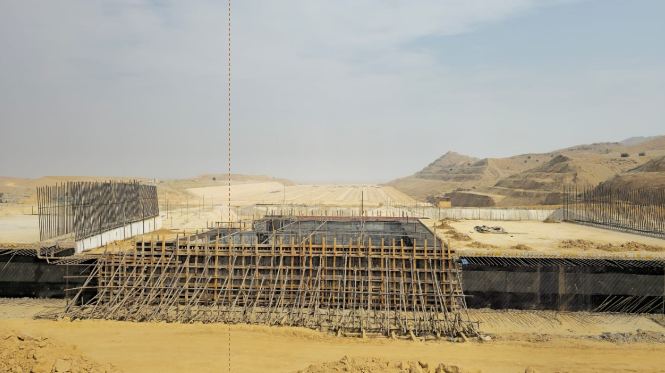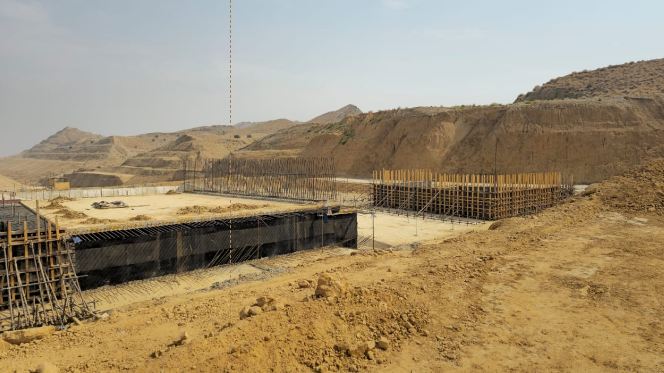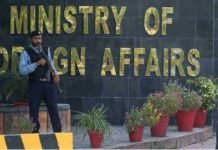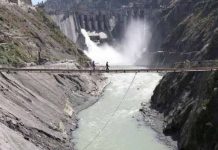Over Rs. 23 billion already spent, but construction halts again as WAPDA awaits funds from federal government for payment to the Contractor ; project faces threat of abandonment.
Nazir Siyal
KARACHI, JUL 13: The much-anticipated Nai Gaj Dam project a crucial infrastructure development meant to control floods and ensure round the year water supply to transform water and agriculture landscape of region in Dadu district, is now teetering on the brink of collapse due to persistent funding delays, price escalations, and administrative bottlenecks.

Nestled in the Kheerthar Range and fed by the seasonal Gaj River, the dam is being constructed under the supervision of WAPDA to address frequent flooding in the Kachho region, enhance irrigation for 28,800 acres, and provide water to Manchar Lake through a 52-kilometer pipeline. It also includes plans to generate 4.2 MW of electricity.
However, according to Syed Ali Akhtar Shah, a WAPDA Water Wing official, the project’s fate is increasingly uncertain due to the non-release of promised funds.
He warned that further delays could nullify the years of effort and billions already invested.
Initially approved by ECNEC in 2009 with a cost of Rs. 16.924 billion, the project was marred from the beginning. The lowest bid in 2012 came in at Rs. 38.792 billion, creating a funding gap and delaying the start. By 2012, a revised PC-I estimated Rs. 59.414 billion, was submitted but at the cost of major cutbacks, including the powerhouse, access roads, and pipeline to Manchar Lake it was approved for Rs. 26 Billion
Despite, expectations to finish by 2015, only 38% of the project had been completed by 2018, with Rs. 11.543 billion released. A scandal in 2018 involving a fake performance guarantee forced WAPDA to terminate the contractor, halting the project for 40 months, until the matter was resolved through Arbitration under directives of High Court of Sindh.
In 2021, WAPDA submitted a second revised PC-I of Rs. 47.732 billion, restoring the key components cut earlier. The work was restarted on October 2021 with understanding to complete the Project in three years by October 2024. However progress again remained slow due to unprecedent price hike in construction inputs followed by Flood ls 2022 which caused flooding and damages of access roads and suspension of work for about six months.
Even after a 2023 agreement to unfreeze the price escalation clause under judgement of Sindh High Court in November 2022 WAPDA faced fresh difficulties in payment to the Contractor.
In FY 2024–25, the federal government allocated Rs. 5 billion, but released only Rs. 3 billion, insufficient to maintain momentum but this financial year 2025-26, the total 500 million rupees were allocated which caused more disturbance in the completing of work of the project as contractor halted work site.
By March 1, 2025, work was suspended once again due to non-release of further funds.
Rafiq Ahmed Jamali, PPP MNA from Dadu, told this Correspondent that chronic underfunding has made it impossible for the project to meet targets. He emphasized the importance of resuming and sustaining progress.
Former federal minister Liaquat Ali Jatoi warned that the contractor may terminate the contract entirely if dues are not cleared promptly. “This would mean a total waste of over Rs. 23.231 billion already invested,” he said, urging immediate intervention by both federal and provincial governments.
Ahmed Waheed Bhatti, the project manager, confirmed that 1,500 staff members were demobilized after WAPDA failed to clear Rs. 4.2 billion in dues, blaming the Ministry of Water Resources for the hold-up.
Pir Babar local inhabitant of Nai Gaaj Dam said that the Nai Gaj Dam, once hailed as a game-changer for water security and flood protection in the region, now stands as a stark example of bureaucratic paralysis and financial mismanagement.
The renowned environmentalist Nasir Panhwar told this correspondent that if funding remains inconsistent, experts warn, not only could the dam remain incomplete, but the Kachho region may also continue to suffer seasonal devastation, water shortages, and agricultural decline.
He said that without immediate corrective steps, this critical project risks joining the long list of abandoned public-sector infrastructure dreams in Pakistan.

















